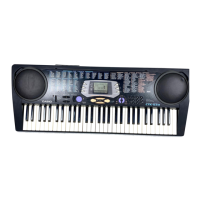
Do you have a question about the Casio CTK-531 and is the answer not in the manual?
| Brand | Casio |
|---|---|
| Model | CTK-531 |
| Category | Electronic Keyboard |
| Language | English |
Lists symptoms indicating low battery power or instrument malfunction for user reference.
Provides FCC guidelines for device usage in the USA and general notices.
Details the keyboard's 100 tones, 100 rhythms, auto accompaniment, and 100-tune Song Bank.
Explains the Musical Information System display and MIDI compatibility functions.
Introduces safety symbols and warnings used throughout the manual.
Covers AC adaptor handling, placement on unstable surfaces, and foreign object risks.
Illustrates safety symbols and actions that must be performed or avoided.
Details procedures for instrument malfunctions, damage, and safety around children.
Provides guidelines for safe AC adaptor use, battery handling, and instrument transport.
Covers cleaning, suitable locations, and avoiding damage to furniture.
Details precautions for volume levels, LCD display, and optional stand usage.
Advises on avoiding heat, humidity, sunlight, and using appropriate cleaning methods.
Illustrates the keyboard layout, including control panel buttons and rear panel connections.
Details the MIDI OUT, MIDI IN, Sustain, Phones/Output, and DC 9V jack terminals.
Provides specific instructions for attaching the score stand to the keyboard.
Explains the various indicators on the display and provides important usage notes.
Provides a step-by-step guide for selecting and playing a Song Bank tune.
Details how to pause, resume, fast reverse, and fast forward song playback.
Explains how to exit the Song Bank mode and return to the tone selection screen.
Describes connecting headphones and audio equipment to the keyboard.
Guides on connecting to audio equipment and musical instrument amplifiers.
Details connecting a sustain pedal and mentions available accessories.
Explains how to load batteries and provides essential battery usage information.
Covers the Auto Power Off function, its behavior, and how to disable it.
Guides on how to play the keyboard and select different tones.
Explains polyphony limits and the technology behind digital sampling for tones.
Details how to select rhythms and start or stop rhythm playback.
Explains how to adjust tempo and use the graphic metronome.
Guides on playing chords to activate auto accompaniment patterns.
Describes the CASIO CHORD and Fingered accompaniment styles.
Explains how to insert fill-in patterns and use the synchro start feature.
Details how to adjust the volume for accompaniment parts.
Provides detailed steps for selecting and playing songs from the Song Bank.
Explains how to change the tempo for Song Bank tunes.
Guides on changing the melody tone and playing along with Song Bank tunes.
Covers two-hand tunes, applause sound feature, and consecutive playback.
Details how to set the keyboard to play Song Bank tunes consecutively.
Explains what a chord is and how to identify chord names and inverted forms.
Guides on entering Chord Book mode and displaying chord information.
Details clearing previous input and specifying chord types like major or minor.
Explains how to play chords using the keyboard after looking them up.
Provides a reference chart for chord type modifiers and their corresponding keys.
Guides on how to transpose the keyboard's key and tune the instrument.
Explains how to turn touch response on/off for expressive playing.
Introduces MIDI (Musical Instrument Digital Interface) and its purpose.
Details how to connect MIDI devices and explains MIDI channels.
Explains the General MIDI standard for sound sources and compatibility.
Guides on modifying MIDI parameters like Tone Map and Keyboard Channel.
Addresses issues like no keyboard sound and problems related to battery power.
Troubleshoots problems with auto accompaniment and Song Bank playback.
Resolves issues with MIDI sound output and connecting to computers.
Lists keyboard models, tone count, polyphony, and rhythm specifications.
Details specifications for display, MIDI, power supply, and output terminals.
Provides a table mapping notes to MIDI note numbers and general MIDI numbers.
Explains different range types for MIDI data reception and playback.
Shows left-hand fingerings for various chords in Fingered Mode.
Lists percussion sounds and their corresponding key assignments on the keyboard.
Details transmitted and recognized MIDI messages, parameters, and remarks.